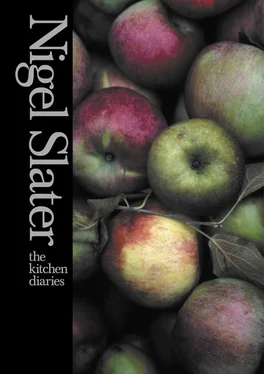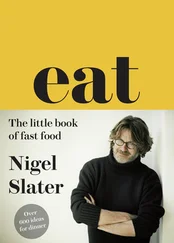Stew Stew pot barley – 100g onions – 3 medium celery – 2 large stalks a large parsnip carrots – 2 potatoes – 4–5 medium neck of lamb chops – 8 thick ones a few sprigs of thyme and a couple of bay leaves white pepper water or stock to cover parsley – a small handful Boil the pot barley in unsalted water for a good twenty-five minutes, then drain it. Get the oven hot. It needs to be at 160°C/Gas 3. Peel the onions and slice them into thick rings. Cut the celery into short lengths. Peel the parsnip, carrots and potatoes and cut them into fat chunks. That’s 2–3cm if you are measuring. Pile the vegetables into a large, deep pot, then tuck in the chops, thyme and bay leaves. Season with a little white pepper, no salt, then pour in the drained barley and enough water or stock to cover the meat and vegetables completely. Bring it slowly to the boil. Skim off the worst of the froth that has accumulated on the surface, easily done with a ‘holey’ spoon. Cover the top of the stew with a sheet of greaseproof paper, then with a lid. Transfer the pot to the oven and leave it there, untouched or fiddled with, for a good two hours. Remove the lid. The liquor should be thin, thickened only slightly by the potatoes. Chop the parsley and mix it in carefully, so as not to smash the vegetables, then season with salt and black pepper. Leave overnight. Next day, skim the fat from the top, then reheat slowly on the stove till the meat is thoroughly hot and the broth gently bubbling. Check the seasoning – be generous – and serve piping hot. Enough for 4
A frosted marmalade cake A frosted marmalade cake I don’t, as a rule, like icing. Yet on a home-made cake, drizzled over so that it sets wafer thin, it adds a welcome contrast to the soft sponge. You could use water to mix the icing but I prefer to use fruit juice, occasionally adding a hint of orange blossom water to perfume each slice of cake. butter – 175g golden unrefined caster sugar – 175g a large orange eggs – 3 large orange marmalade – 75g self-raising flour – 175g For the frosting: icing sugar – 100g orange juice – 2 tablespoons Set the oven at 180°C/Gas 4. Line a loaf tin about 25 x 11cm and 7cm deep. Put the butter and sugar in a food mixer and beat till pale and fluffy. Finely grate the orange. Break the eggs into a small bowl and beat them lightly with a fork. With the machine set at moderate speed, pour in the beaten egg a little at a time, beating thoroughly between each addition. Beat in the marmalade and the grated orange zest. Remove the bowl and fold in the flour with a large metal spoon. Do this slowly, firmly but carefully, till there is no sign of any flour. Lastly, gently stir in the juice of half the orange. Spoon the mixture into the lined tin, lightly smoothing the top. Bake for forty minutes, checking it after thirty-five with a metal skewer. Leave to cool in the tin – it will sink slightly – then remove and cool completely on a wire rack. Sift the icing sugar and mix it to a smooth, slightly runny consistency with as much of the remaining orange juice as it takes – probably just under two tablespoons. Drizzle the icing over the cake, letting it run down the sides, and leave to set. Enough for 8
Frozen yoghurt with roast rhubarb Frozen yoghurt with roast rhubarb Warm, rudely pink rhubarb and snow-white frozen yoghurt has a smart, bright flavour and is breathtakingly pretty on a cold winter’s day. The frozen yoghurt is simply a bought vanilla smoothie chucked into an ice-cream machine; the baked fruit just rhubarb bunged in a dish with a spoonful of runny honey and the juice of an orange. thick vanilla yoghurt smoothies – 3 × 250ml young, pink rhubarb – 500g an orange mild honey – a tablespoon To make the frozen yoghurt, pour the smoothies into the drum of your ice-cream machine and churn till almost frozen. Scoop out and into a plastic freezer box, then keep in the freezer till you need it. Cut the rhubarb into short lengths about the size of a wine cork. Lay them in a shallow stainless steel or glass baking dish, squeeze over the orange juice and drizzle with the honey. Bake for twenty-five minutes at 200°C/Gas 6, occasionally spooning the juices over the fruit. The rhubarb is done when the stalks are tender enough to crush between your fingers. Leave to cool a little. Divide the warm rhubarb between four dishes, then place a couple of scoops of frozen yoghurt on each, though it looks rather elegant served in separate bowls. Enough for 4 Note To make the frozen yoghurt without a machine, pour the smoothies into a plastic box and freeze for a couple of hours till a thick layer of ice crystals forms around the edge. Whisk the frozen edges into the middle of the mixture, then freeze again for an hour or so. Repeat, again beating the edges into the middle. Now leave the mixture to freeze. The whole process will take about four hours, depending on the temperature of your freezer. Try to catch the ice just before it freezes solid. The texture will be less smooth than if you use a machine.
Double ginger cake Double ginger cake I am rather proud of this cake. Lightly crisp on top and with a good, open texture, it is light, moist and delicately gingery. It will keep for a week or so wrapped in paper and foil. self-raising flour – 250g ground ginger – 2 level teaspoons ground cinnamon – half a teaspoon bicarbonate of soda – a level teaspoon a pinch of salt golden syrup – 200g syrup from the ginger jar – 2 tablespoons butter – 125g stem ginger in syrup – 3 lumps, about 55g sultanas – 2 heaped tablespoons dark muscovado sugar – 125g large eggs – 2 milk – 240ml You will need a square cake tin measuring approximately 20–22cm, lined on the bottom with baking parchment or greaseproof paper. Set the oven at 180C/Gas 4. Sift the flour with the ginger, cinnamon, bicarbonate of soda and salt. Put the golden and ginger syrups and the butter into a small saucepan and warm over a low heat. Dice the ginger finely, then add it to the pan with the sultanas and sugar. Let the mixture bubble gently for a minute, giving it the occasional stir to stop the fruit sticking on the bottom. Break the eggs into a bowl, pour in the milk and beat gently to break up the egg and mix it into the milk. Remove the butter and sugar mixture from the heat and pour into the flour, stirring smoothly and firmly with a large metal spoon. Mix in the milk and eggs. The mixture should be sloppy, with no trace of flour. Scoop the mixture into the lined cake tin and bake for thirty-five or forty minutes, until a skewer inserted in the centre of the cake comes out clean. Unless you are serving it warm, leave the cake in its tin to cool, then tip it out on to a sheet of greaseproof paper. Wrap it up in foil and, if you can, leave it to mature for a day or two before eating. Enough for 8
Onion soup without tears January 11 Onion soup without tears I do love the classic onion soup, simmered for hours in a deep iron pot, but if I’m honest I hate making it. Onions make me cry at the best of times, but slicing enough for an entire pan of soup is more than I can handle, so this method where you roast the halved onions first solves all that. But there is more to this soup than convenience for those easily brought to tears; the roasting of the onions gives a sweet, caramel depth to the broth and the onions turn silky, slithery and soft. I could also add that the smell of onions baking in butter is a rather more attractive option than the pong of boiled onions wafting through the house. onions – 4 medium butter – 40g a glass of white wine vegetable stock – 1.5 litres a small French loaf grated Gruyère, Emmental or other good melting cheese – 150g Set the oven at 200°C/Gas 6. Peel the onions and cut them in half from tip to root, then lay them in a roasting tin and add the butter, salt and some pepper. Roast until they are tender and soft, and toasted dark brown here and there. You might have to turn them now and again. Cut the onions into thick segments. Put them in a saucepan with the wine and bring to the boil. Let the wine bubble until it almost disappears (you just want the flavour, not the alcohol), then pour in the stock. Bring to the boil and simmer for about twenty minutes. Just before you want to serve the soup, make the cheese croûtes. Cut the loaf into thin slices and toast lightly on one side under a hot grill. Turn them over and sprinkle with the grated cheese. Get the soup hot, ladle it into bowls and float the cheese croûtes on top. Place the bowls under a hot grill and leave until the cheese melts. Eat immediately, whilst the cheese is still stringy and molten. Enough for 4
Читать дальше












